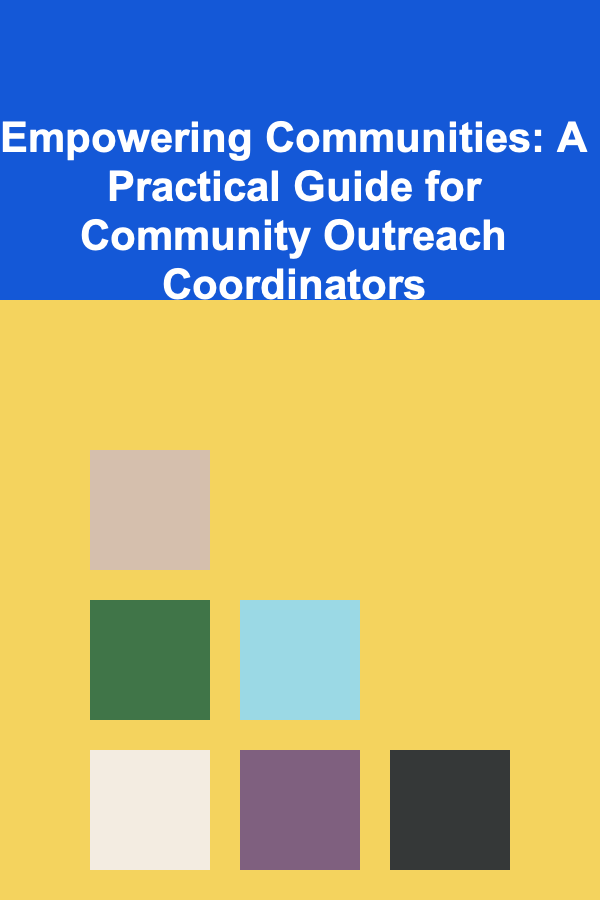
Empowering Communities: A Practical Guide for Community Outreach Coordinators
ebook include PDF & Audio bundle (Micro Guide)
$12.99$7.99
Limited Time Offer! Order within the next:

Community outreach coordinators are the driving force behind initiatives that connect organizations to their communities. They bridge gaps, identify needs, and create solutions that foster social change and well-being. While the role is dynamic and often involves multiple tasks, the heart of effective community outreach lies in empowering people. The more engaged and empowered individuals and groups feel, the more sustainable the outcomes of outreach programs will be. This guide is designed to provide actionable insights that will help community outreach coordinators build stronger, more resilient communities through empowerment.
Understanding Empowerment: The Key to Long-term Success
Empowerment in the context of community outreach involves enabling individuals and communities to take control of their own lives, make decisions, and solve problems that affect them. It's about giving people the tools, knowledge, and confidence to drive change within their own communities. This process is collaborative rather than top-down, recognizing the expertise and strengths already present within the community.
Why Empowerment Matters
Empowering community members fosters a sense of ownership and responsibility. When individuals feel in control of decisions that affect their lives, they are more likely to be engaged, take initiative, and work together to solve problems. Moreover, empowerment promotes equity and social justice by ensuring that marginalized groups have the tools they need to advocate for themselves and achieve their goals.
Actionable Steps to Begin Empowerment
- Start with Capacity Building: Help individuals and groups within the community build skills that are directly applicable to addressing their own needs. This might include providing leadership training, organizing community organizing workshops, or offering technical skills workshops.
- Encourage Self-Advocacy: Provide platforms for people to voice their concerns, whether through town halls, feedback forms, or one-on-one consultations. Make sure that the voices of traditionally underserved groups are heard and amplified.
- Provide Resources for Independence: Empowerment involves giving people the resources they need to make informed decisions. This could involve providing information about local laws, social services, education opportunities, or financial literacy.
Building Strong Relationships: The Bedrock of Effective Outreach
Building meaningful, trust-based relationships with community members is the cornerstone of effective outreach. Relationships that are grounded in trust encourage more active participation and ensure that your outreach efforts are truly responsive to the needs of the community.
Why Relationship Building is Essential
Trust fosters open communication and collaboration. When community members trust that you have their best interests at heart, they are more likely to engage in programs, contribute their ideas, and commit to long-term involvement. Strong relationships also create an environment in which people feel safe sharing their concerns and collaborating on solutions.
Actionable Steps for Relationship Building
- Be Present and Accessible: Attend local meetings, social events, and other gatherings to familiarize yourself with the community and build rapport. Don't just show up when you need something; become a consistent and visible part of the community fabric.
- Invest in Listening: Active listening is a key element of building relationships. Ask open-ended questions and listen without judgment. Showing that you truly care about what people say will deepen the trust they place in you.
- Show Consistency and Reliability: Follow through on your promises. If you say you will provide a resource or information, ensure that you deliver it. Trust is built through reliability, and maintaining your word will strengthen your relationships over time.
Leveraging Community Strengths: Identify and Mobilize Local Assets
Every community has unique strengths that can be mobilized for collective action. As a community outreach coordinator, one of your key responsibilities is to identify these strengths and find ways to leverage them for greater impact. Whether it's local leaders, established community organizations, or informal networks, tapping into these assets is key to ensuring your outreach efforts are sustainable.
Why Leveraging Local Assets is Crucial
Mobilizing community assets encourages local ownership of projects. It creates an environment where solutions are community-driven and ensures that the initiative is grounded in local knowledge and capacity. When people use their own resources, the initiatives are often more effective, sustainable, and culturally relevant.
Actionable Steps for Asset-Based Outreach
- Map Community Resources: Take the time to conduct a thorough asset mapping exercise. This involves identifying the skills, knowledge, institutions, and resources that exist within the community, including local businesses, religious organizations, schools, and volunteers.
- Collaborate with Local Leaders: Local leaders---whether formal or informal---play an essential role in building momentum for initiatives. Engage them early on and ask for their support in rallying the community around key efforts.
- Support Community-Led Initiatives: When community members take the lead on initiatives, they are more invested in ensuring their success. Offer your support in ways that amplify the efforts of community members rather than overshadowing them. This might mean providing funding, technical assistance, or other resources that enhance the work they're already doing.
Inclusion and Accessibility: Ensuring Equal Participation for All
One of the key principles of community empowerment is inclusion. Ensuring that all voices are heard and that people from diverse backgrounds have equal access to opportunities is fundamental to creating a truly empowered community. For outreach efforts to be meaningful, they must be accessible to everyone, including marginalized groups such as those with disabilities, seniors, immigrants, and low-income individuals.
Why Inclusion and Accessibility Matter
Inclusive outreach programs make sure that no one is left behind. By actively engaging people from diverse backgrounds, you foster a sense of belonging and make sure that the solutions you implement address the needs of the entire community. Inclusion also helps build social cohesion and reduces divisions between different groups.
Actionable Steps for Ensuring Inclusion
- Ensure Accessible Formats: Make sure that all outreach materials, whether in print, online, or in person, are accessible to people with disabilities. This might mean providing information in multiple languages, offering captioning for videos, or ensuring that events are wheelchair accessible.
- Engage Underrepresented Groups: Identify and reach out to groups who are typically excluded from mainstream outreach efforts. This could include those who face language barriers, people with disabilities, or individuals who are socially or economically marginalized.
- Create Safe Spaces for Dialogue: In order for people to truly feel empowered, they need to feel that they can express their thoughts and concerns without fear of judgment or retaliation. Foster an environment of trust and mutual respect where all voices are welcomed and valued.
Communication Strategies: Effective Tools for Outreach
Effective communication is at the core of all successful community outreach efforts. A well-thought-out communication strategy ensures that the right message is reaching the right people at the right time. As a coordinator, you need to adapt your communication methods to suit the community's preferences and needs.
Why Communication is Key
Clear, consistent communication helps ensure that community members understand the initiatives you are implementing and how they can get involved. Effective communication also promotes transparency, fosters a sense of involvement, and encourages participation. Furthermore, it helps manage expectations and reduce confusion.
Actionable Steps for Effective Communication
- Use Multiple Channels: Different community members will respond to different forms of communication. Use a variety of channels such as social media, email newsletters, flyers, local radio, and in-person meetings to get your message out. Make sure to tailor your message depending on the medium.
- Keep It Simple and Clear: Avoid jargon and overly technical language. Use clear and simple messaging to ensure that everyone, regardless of their background or literacy level, can understand and engage with your materials.
- Be Transparent and Honest: In all your communications, be clear about the goals of your outreach efforts, the resources available, and the expected outcomes. Transparency builds trust and helps manage expectations.
Evaluating Impact: Continuous Improvement for Lasting Change
The work of a community outreach coordinator doesn't stop once an initiative is implemented. Evaluating the impact of your outreach efforts is essential to understanding what worked, what didn't, and where improvements can be made. Effective evaluation helps ensure that your programs remain relevant, sustainable, and capable of creating long-term positive change.
Why Evaluation is Important
Evaluation provides the insights you need to assess the effectiveness of your outreach efforts. By tracking progress, gathering feedback, and analyzing outcomes, you can adjust your strategies to better meet community needs. It also demonstrates accountability, which is crucial for maintaining the trust of the community.
Actionable Steps for Evaluation
- Collect Data: Use both qualitative and quantitative methods to gather data on your outreach initiatives. This could include surveys, focus groups, interviews, and participation tracking.
- Get Feedback from the Community: Ask community members for their input on the outreach efforts. What worked for them? What challenges did they encounter? Use this feedback to fine-tune future programs.
- Track Long-Term Outcomes: Look beyond short-term participation rates and consider the longer-term impact of your efforts. Are community members sustaining the changes? Are they continuing to collaborate with each other? Are there signs of increased empowerment?
Conclusion
Community outreach is not just about delivering services or programs---it's about building relationships, fostering empowerment, and ensuring that the community has the tools to continue thriving long after the outreach coordinator has moved on to the next initiative. By focusing on empowerment, relationship building, community assets, inclusion, effective communication, and ongoing evaluation, outreach coordinators can create programs that are not only impactful but sustainable. The real work lies in working alongside community members to ensure that their voices are heard, their strengths are leveraged, and their needs are met in a way that promotes long-term, self-sustained change.
Reading More From Our Other Websites
- [Personal Care Tips 101] How to Remove Nail Polish Without Damaging Your Nails
- [Home Space Saving 101] How to Sustain the KonMari Method for Small Spaces: Long-Term Strategies for Keeping Clutter at Bay
- [Home Family Activity 101] How to Make Learning Fun with Family Trivia Nights
- [Home Rental Property 101] How to Protect Your Rental Property from Seasonal Damage
- [Personal Care Tips 101] How to Use Hair Mousse for a Long-Lasting Hold
- [Weaving Tip 101] From Loom to Palette: Modern Techniques in Weaving and Dyeing
- [Home Budget 101] How to Create a Budget for New Homeowners and Stick to It
- [Gardening 101] Avoid Over‑Fertilizing: A Practical Checklist for a Healthy, Balanced Garden
- [Organization Tip 101] How to Organize a Charity Drive in Your Community
- [Organization Tip 101] How to Organize Your Kids' Homework Station

How to Maintain Your Home Without Going Over Your Budget
Read More
How To Master Zoning and Area Denial in FPS Games
Read More
How To Price Your Products or Services
Read More
How to Monitor and Predict Consumer Behavior Shifts in the Metaverse
Read More
How to Effectively Manage Executive Communications
Read More
10 Tips for Budgeting with a HELOC: A Comprehensive Guide
Read MoreOther Products

How to Maintain Your Home Without Going Over Your Budget
Read More
How To Master Zoning and Area Denial in FPS Games
Read More
How To Price Your Products or Services
Read More
How to Monitor and Predict Consumer Behavior Shifts in the Metaverse
Read More
How to Effectively Manage Executive Communications
Read More